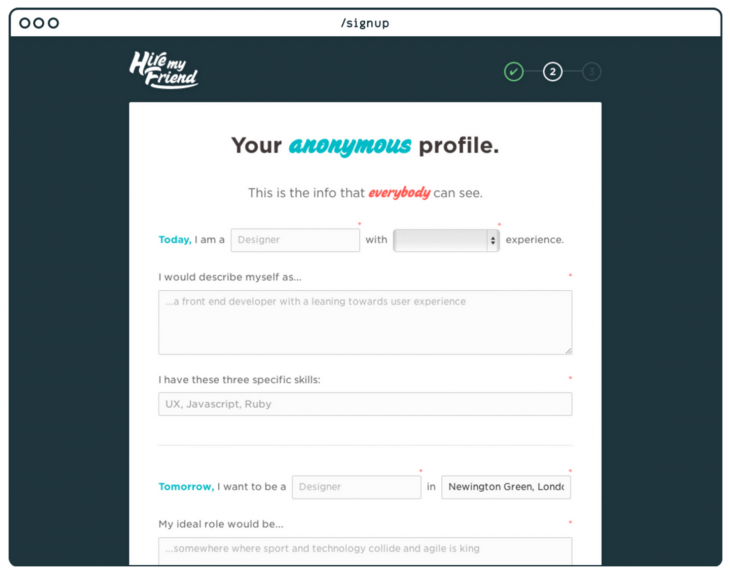
Nick Marsh is the founder at Makeshift. This post originally appeared on Medium.
I want to introduce a new
concept — ‘talent hacking’. I define this as the creative application of technology and data to the problem of building new teams.
I’m trying to coin this phrase in part to highlight how we’ve bizarrely neglected the ‘people’ part of the startup stack. We’ve seen methodological revolutions in how we build technology, manage products and do marketing in recent years. But the processes involved in hiring and managing people seem to have barely changed at all.
It’s time to change that by learning from what’s working in other parts of the startup movement and applying it to the people bit.
I’m calling this ‘talent hacking’, and this article is my first attempt to bring together some of these ideas in one place.
Why talent hackers?
First, a confession. I’ve shamelessly stolen the ‘talent hacker’ idea from the ‘growth hacking’ movement.
Growth hacking emerged a few years ago to define the hybrid technical / marketing role within internet startups that was focused on quick growth in user numbers. This enabled startup people who weren’t marketers to understand and embrace the most important aspects of that field — the need to quickly grow your audience, and from there your business.
As a stripped-down form of early-stage marketing, growth hacking puts an extra emphasis on metrics, especially the cost to acquire a customer. It then combines this with an aggressive use of technology, as well as a ‘no holds barred’ approach to opening up new channels.
Implicit in the concept is that growth hacking is simultaneously everyone’s responsibility in a company and also an individual specialism: the whole firm should be concerned with growth, but some people should be given free reign to hack totally new channels.
The time has come for a similar revolution in the recruitment and HR departments of early stage companies.
Don’t miss: What is an Entrepreneur in Residence?
The problem
Hiring and management practices are still stuck in the dark ages of business: poorly measured, expensive, beholden to ‘the way things have always been done’ and populated by shiny-suited commission-driven sales people. Even worse, the culture of ‘you’re lucky to have a job’ is still floating around some circles.
Fortunately, change is already here — all across the world companies are experimenting with new ways of hacking the process of sourcing, hiring and building teams, fast, on tight budgets.
Big internet firms like Zappos are ditching hiring shibboleths like job descriptions and CVs, while investment firms like Andreessen Horowitz are building in-house talent agencies, and smaller startups like Driftrock are using their speed advantage to jump on new hiring channels like Twitter Ads.
The people leading this change are talent hackers, and if your startup is growing quickly, you need to make them a priority hire.
Some background — my recent experience helping startups hire
Six months ago my company, Makeshift, launched a product called Hire my Friend — a friendly startup-focused recruitment service, designed to mimic the way many smart people get jobs, via referrals from friends.
We’ve been very flattered by the number of candidates that have registered with our service (13,000 and growing every day), but we’ve been totally overwhelmed with the response from companies — over 1000 companies have applied to join without us doing a single piece of targeted company marketing.
Every time I meet a CEO, CTO or a senior person responsible for hiring in a startup I hear the same thing — the recruitment industry and recruitment practices are totally broken.
During the early stages of Hire my Friend we conducted customer development interviews with some of our early users. One CTO I spoke with, tasked with recruiting tech talent for their project which had recently raised over $1M on Kickstarter told me that:
“Hiring is difficult, time consuming, frustrating, boring, stressful and heartbreaking.”
Isympathise with this. I’ve spent the last five years or so building teams in small digital companies, and I agree — hiring is really, really hard. But why?
The talent market for startups — very competitive and changing fast
First, it’s clear to anyone working around internet tech that there is a massive, sustained boom in our sector, that has led to a significant talent drought, especially amongst developers and technical designers. In London alone, internet firms are expected to create an extra 46,000 jobs in the next ten years.
Behind the absolute increase in available jobs lies a change in the nature of the firms hiring. In particular, startups are getting smaller, quickly come and go, and sometimes grow extremely fast. This Economist report calls it a ‘cambrian moment’.
This has led to a huge gap between the jobs available and the people to fill them. There simply aren’t enough good programmers, designers, digital marketers, experienced ops people to fill these roles. Nearly half of London’s startups say that a lack of talent is the biggest factor restricting their growth.
This shift in the types of companies hiring and the labour market has led to some important changes in how the hiring is happening within startups.
Candidates have the advantage. It used to be that firms had the upper hand, but now, good candidates can pick and choose between employers: if you leave your technical job tomorrow, you can get another one the next day. So this means that companies have to work much much harder to attract good people.
Inexperienced managers find themselves tasked with hiring. This is especially true for companies founded by younger entrepreneurs. People who may have only had one job before starting their company, are suddenly hiring 20 or 30 people in a year. These people have to learn the art of hiring very quickly.
Rapid hiring happens after investment rounds. After a firm has a large seed round or series A, investors expect a sudden uptick in headcount, typically within a few months, so talent pipelines have to get shorter, decisions faster.
Self-organising teams are needed to manage explosive growth. When a startup is experiencing serious growth, say doubling in size every six months, a new type of self-organising management is required, as traditional top down management can’t cope. This has big implications for HR process development and company culture creation — hugely important parts of the talent hacker’s stack.
In summary, we’re seeing big changes in how early stage companies hire. It’s even been called a new industrial revolution that will change the way we work for the foreseeable future. As The Economist says “the world of startups today offers a preview of how large swathes of the economy will be organised tomorrow.”
Current hiring methods are static and broken for early stage startups
The amazing thing is that amid all this change, sourcing and hiring practices have hardly changed at all, especially for smaller firms. Everyone that works in startups will be familiar with the standard process for hiring people. It looks something like this…
1. Define the job
Management identifies a new role to be created. A salary is kicked around and feedback requested on the skills needed. If anyone has a friend that fits the bill they normally pipe up at this point and suggest an interview. No one thinks about any direct spend at this point.
After this, someone writes up a ‘job description’ that lists various skills that the team assume are required to do the role, normally accompanied by a breathless description of the unbelievably exciting expected duties.
Most programming job descriptions basically translate to this: how compatible are you with our ongoing poor choices and can you save us?
— Akiva (@akiva) June 10, 2014
2. Source some candidates
The job description makes its way to a company website somewhere, gets included in a newsletter, maybe tweeted … and then the team have a think about what to do with it to actually get some applicants.
At this point, there is the realisation that money may have to be spent,so someone may throw a few hundred dollars at a job board ad or two.
At this stage it gets fuzzy. If a firm has a good brand, and a good community around it, things proceed to the next step — screening applicants and doing interviews.
If not, the person tasked with making the hire may proceed to some active sourcing, normally a combination of Linkedin mining, emailing friends and colleagues, and hoping to avoid the inevitable next step — speaking to a professional recruiter.
This last step is normally taken as a last resort, normally because the firm is desperate. Finding a positive story about an interaction between a tech firm and an agency recruiter is a very, very rare thing. But if this step is taken, the firm is then on the hook for an average placement fee of 20% of the new hire’s salary, typically around $16,000 in the internet industry.
Suddenly, this hire just got very expensive — and that idea of not spending any money goes out the window.
3. Screen and interview
Eventually we get to the next phase, screening and interviewing. Assuming the job description has been seen by some people that could actually do the job, they apply with a ‘curriculum vitae’ — essentially a self declared list of things the candidate says they can do, as well as some kind of cover letter.
If the team like the look of this arbitrary document, they may choose to progress the candidate to the next stage — interviews.
Interviewing skills vary enormously. Some people are very good at it, and some firms train their managers in effective interviewing techniques. But most small companies don’t.
The end result is that interviews are often more of a chat about industry topics, with no guarantees that two candidates will get the same interview, often preceded by the candidate telling their life story, and ending with some trivial conversation about non-work-related activities.
Eventually, when the team has spoken to enough people, a decision is made. An offer is put forward to a candidate. If they accept, they start three or four weeks later. If a recruiter was involved, a large sum of money changes hands.
And only then, when work starts, do they get to figure out if the job to be done and the candidate match up.
If you nodded your head at any of the above, its time to start thinking differently.
What’s wrong with this?
While clearly a characterisation of some of the worst practices, from my own conversations with startups and SMEs, many firms (including ones I’ve been involved with) have used all or some of this non-process to hire their team.
Matt Buckland at Forward partners puts it like this:
“Hiring is still waterfall in an agile world”
There’s so much wrong here, but here’s a few of the most glaringly broken elements:
No budget leads to a huge budget. Smaller companies often hope to make a hire without spending anything. This kind of attitude can lead to only a small number of applicants, and finally a desperate recourse to recruiters, who of course charge a fortune.
No measurement leads to no learning and significant (or at least unknown) waste. Along the way, many companies fail to build a data set of what is working to hire great candidates, and what has failed. Without these metrics it’s very hard to make good decisions about where to spend money, and what to improve. This is especially strange in startups, which are often great at analytics, A/B testing and measurement of their products.
Limited sourcing channels leads to limited candidates. Most companies rely on the same small number of sourcing channels to find their candidates — employee referrals, Linkedin, and a small number of job boards. With the exception of referrals, this means they are all competing with each other for the same small pool of people, and when most founders reach the fringe of their immediate networks they start to get very weary.
Job descriptions and CVs leads to very arbitrary screening. Job descriptions and CVs are a very lightweight way of describing work to be done and the people who can do it. Using these documents to make matches is quite arbitrary — put simply, your ability to write a good CV or cover letter may have almost no impact on your ability to do the job.
Interview processes leads to a very limited appreciation of fit and ability. Face to face, conversational (or worse, confrontational) interview situations give very limited insight into a persons ability to do the work required, which is normally collaborative, and focused on producing something.
Third party recruiters (often) suck. Finally, it almost goes without saying, that most external IT recruiters suck. They might be lovely people, but their incentives are all screwed up, which makes their behaviour unhelpful. They work in a very bonus-driven, sales-oriented environments, and often have very limited personal experience of the roles they are filling, and almost no knowledge of the culture they are hiring into.
The cumulative results of all these practices in our industry are profound. You can’t help thinking that “hiring is difficult, time consuming, frustrating, boring, stressful and heartbreaking.”
How to start talent hacking at your company
Now, I don’t have any magic bullets for this problem, but below are some of the behaviours I’ve observed amongst innovative, technically minded recruiters — talent hackers — recently. I’d love to get your feedback on this, and start building a more complete thesis around what works to hire great people in today’s hyper-competitive marketplace. There’s lots more to learn.
Treat talent development as a function. First and foremost, firms need to respect the work required to hack the talent problem. It’s a job, not a side project. This means that sourcing and hiring responsibilities need to be clearly assigned to individuals, and that the work involved in hiring is treated as an exercise in continuous improvement, much like engineering or product development.
TIP: Adapt agile methods to track your hiring. Create a Kanban board of candidates with swimlanes for stages, and do regular standups to update each other on individual candidates.
Have a budget for recruitment, and measures of success. In order to continuously improve, you need clear budgets and measures of success. The aim should be to constantly increase the quality of new hires, whilst simultaneously reducing the cost of each hire.
TIP: Include recruitment and sourcing budgets as line items in your financial planning.
Instrument the process and use data to make better decisions. Once you have budgets, measures of success and people focused on hiring, you need to make sure you are measuring progress.
This doesn’t mean simply producing reports — ‘I sourced 10 people and we hired 1’ — but rather building a queriable data set about what happened, in order that you can answer questions you don’t yet know — ‘which candidate source yielded the most female applicants that got to a third stage interview’.
TIP: Have a look at the kind of Metrics that Matt Buckland tracks at Forward, then start tracking them yourself
Don’t ‘interview’. Instead, find ways to work together before committing. This isn’t always possible but we’ve found that our hiring success is very closely correlated to whether it was possible to work on an actual piece of work together before getting started — normally a small hack or side project. This gives both parties a much better chance of understanding fit.
TIP: Consider paying a candidate as a contractor for one days work in lieu of of an interview process, and then get them to do some real work and have lunch with the team.
TIP #2: Try using a lightweight testing service like Prehash to allow candidates to show what they know in a more realistic setting.
Use alternative sourcing channels. If you are relying on the same sourcing channels as everyone else, you are competing with the biggest, most well funded, well organised talent teams in tech. Instead, why not try hacking your own methods for reaching out to candidates. The best way to show you are innovative is to make the initial approach innovative!
TIP: London based startup Driftrock used Twitter ads to gather candidates.
TIP #2: If you have a specific hire you really want to make, consider doing something very memorable — these guys sent a matrix style phone to prospective creative directors.
TIP #3: Request access to Hire my Friend (our service). It’s full of people who would actively consider moving on.
What next?
As mentioned, this article is meant to ask questions, not provide all the answers!
I hope the talent hacker concept inspires debate about how we can use knowledge gained from other parts of the startup movement to begin improving sourcing, recruitment and HR practices.
Get the TNW newsletter
Get the most important tech news in your inbox each week.









